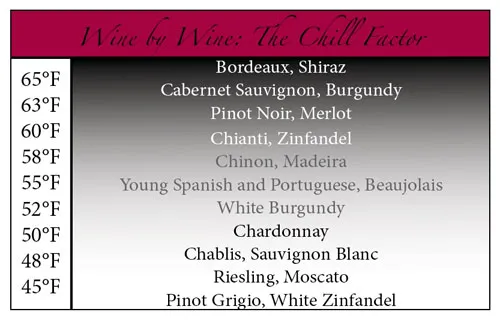I Put Ice in My Wine Because You Don’t Serve it at the Right Temperature
Is there one perfect temperature to serve red or white wine? Perhaps not, but here are some good guidelines
/https://tf-cmsv2-smithsonianmag-media.s3.amazonaws.com/filer/20120802123018WineImageThumb.jpg)
“A glass of the Chianti. With ice on the side.”
While I’ve had more than a few raised eyebrows shot in my direction for willingly diluting my red wines with ice, my distaste for the acetic sting that accompanies warm wine far outweighs my concern for thinning out my drink with a cube or two of ice. I’ve often wondered about the age-old “rule” that red wine should be served at room temperature, while white wines should be served chilled. Personally, I’ve always found room temperature red wine to be, well, repulsive.
It turns out that my uncouth icing of the reds is not completely unjustified. Most red wines are served too warm; the “room temperature” rule originated in Europe, where room temperature is between 60 and 65 degrees Fahrenheit. On the other hand, chilled white wine came from the European cellar, where temperatures hover around 55 degrees Fahrenheit.
In America, to achieve the ideal wine temperature you actually have to cool red wines and warm white wines, assuming your reds are stored in a room temperature wine rack and your whites are kept cold (too cold!) in the refrigerator. Average room temperatures can be over 70 degrees and most refrigerators are a frosty 35 degrees Fahrenheit. One critic recommends putting a bottle of red wine in the fridge for 45 minutes before serving while taking a bottle of white wine out of the fridge 30 minutes prior to serving.
For those with a more refined wine-tasting palette, temperature can be adjusted to accommodate bold, dark versus light, fruity red wines, and white wines can be served warmer or colder depending on whether they are sweet and full or crisp and light. Between a robust Bordeaux and a bright Pinot Grigio, the temperature graduation for serving wine runs between about 65 degrees to 45 degrees Fahrenheit, give or take two or three degrees.

The reason temperature is so important to bringing out the flavor of wines is that warming or chilling wine can unlock different layers of flavors within the wine. Serving wine at a temperature too far from its ideal range may overpower desirable flavors with alcohol or tannins.
When wine is served too warm, the dominant flavor can be that of alcohol, masking the subtler flavors of the wine’s ingredients. This effect is particularly noticeable with strong red wines that have a higher alcohol content to begin with. On the other hand, chilling a wine brings out greater astringency, which means the wine tastes sharp and tart as the flavor of tannins is emphasized. The trick is to find the happy medium for each wine, especially important in bringing out a wine’s aroma. Goldilocks had it right about more than just porridge when she said, “Too hot, too cold….just right.”
The good news is that there are no hard and fast rules for the “exact” correct temperatures for serving wines; it truly is to the preference of the individual. The chart above page can be used as a guideline, but by experimenting with a wine’s temperature, wine enthusiasts can fine tune their favorite “flavor sweet spot” of aromas and flavors.
Even my habit of dumping ice cubes into my red wine turns out to not be completely unrefined, although the practice is definitely a point of contention between wine experts. Famous chef Mario Batali, who was featured on the Food Network’s “Iron Chef America” and his own cooking show “Molto Mario,” has been noted to chill and dilute his wine with fruit-juice-based ice cubes. I’ll consider that permission enough to continue my controversial use of ice.
Cheers to that.